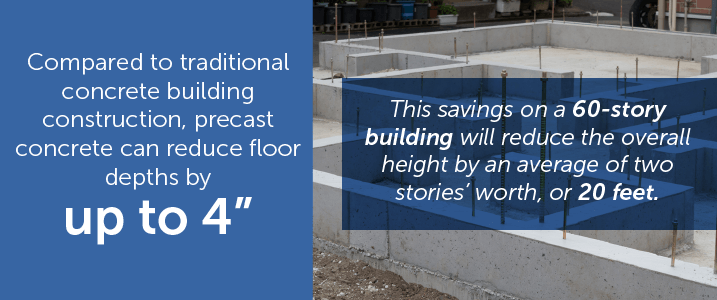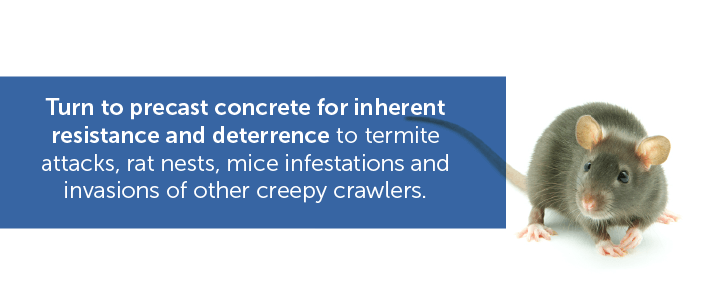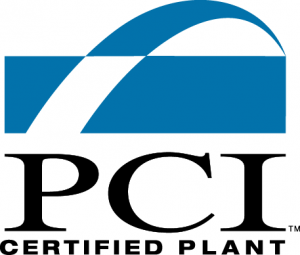![]()
Jump-To:
- Structurally Secure and Effcient
- Prefabricated and Preinstalled
- Weather and Large-Scale Precast Concrete
- Thermal Friendly
- Fire Tough
- Resistant to Chemicals and Rust
- Tough Jobs Every Single Day
- Reduce Noise Inside and Out
- Wi-Fi Friendly
- Keep Pests Out
- Safety and Large-Scale Infrastructure Demands
- Customizable for Your Job
Large-scale construction is a beast in a class of its own, and precast concrete is able to slay almost all of the worries it conjures up. Traditional concrete building construction is fading away as more construction crews, planners and architects discover the precast concrete advantages.
Here are just 12 of the top benefits you’ll see due to precast concrete strength and uniformity. They touch every aspect of building construction from how high you can go to making the final installation of plumbing, electrical, HVAC and other elements significantly easier.
STRUCTURALLY SECURE AND EFFICIENT
Traditional concrete building construction just can’t stand up to the precast concrete advantages and strength, especially when looking at large projects.
Precast concrete is specifically designed and constructed to have a significantly high span-to-depth ratio that allows it to bear loads better, reducing the need for additional columns and supports within the internal structure of the building. Its lighter weight can also reduce the size of needed structural material and overall foundational depth.
Precast concrete strength isn’t sacrificed by its lightweight construction, though, which means it’ll stay secure and even be put under reduced dead loads when properly installed. All of that weight savings paired with high strength means buildings can use precast concrete to reach heights of up to 80 stories.
Precast concrete strength isn’t sacrificed by its lightweight construction, though, which means it’ll stay secure and even be put under reduced dead loads when properly installed. All of that weight savings paired with high strength means buildings can use precast concrete to reach heights of up to 80 stories.
The NCPA’s guide to precast concrete says that, compared to traditional concrete building construction, precast concrete can reduce floor depths by up to four inches. So, this savings on a 60-story building will reduce the overall height by an average of two stories’ worth, or 20 feet.

All of that precast concrete uniformity means it is a denser construction that can reduce vibrations that move throughout the building. So for large-scale projects, especially those with open areas like concert halls, vibration in seats and stands is reduced to help increase enjoyment and minimize the risk of structural damage from large crowds.
These elements combine to make precast concrete an extremely safe building material that can help your construction crew meet the safety requirements for projects of almost any size and shape.
PREFABRICATED AND PREINSTALLED
Tilt-up concrete construction requires pouring and molding onsite limits what you can use it for when it comes to internal structures and foundations, as well as when your job requires significant utility access. For example, an airport has a vast array of technology that must always be operable, but it can’t have wires or other overhangs that move across its yard. This means everything possible runs through the foundation and base of the buildings.
Precast concrete allows construction teams to preinstall utility access, fixtures and other elements. Some of the more common inclusions are plumbing and communication lines, though the NPCA notes that preinstalled elements can even include windows.
During and after the precast concrete is made and molded, different utility panels can be added and installed. This allows construction crews to ensure there is access to utilities and other elements right away, so there’s less need for revisions or alteration of the concrete.
Larger elements can also be checked by electricians, plumbers and other specialized professionals before those blocks and units are installed. Crews only need to worry about connecting each unit and then performing a final test because each piece will be operational as it arrives.
Pre-installation of elements is a top way that precast concrete can save construction companies money and help them deliver projects on time, or even early — which is a significant way to boost a reputation.
WEATHER AND LARGE-SCALE PRECAST CONCRETE
Precast concrete is able to withstand flood damage, wind-blown debris, rain penetration and the methods we use to protect buildings and roads from these dangers. Studies have found that it can withstand many freeze-thaw cycles even better than other construction and building materials, so it won’t decay or crumble as it expands and contracts.

Precast concrete’s strength and uniformity allow it to withstand these elemental changes more successfully than traditional concrete building construction.
THERMAL FRIENDLY
Large-scale infrastructure requirements create unique weather and element demands, including the ability to keep heat in during the cold months and keep heat out in the summer. When you’re not using the right materials, you’re looking at a significantly increased cost all year long.
Precast concrete advantages for the building owners are big, but many believe it’s thermal efficiency that’s among the most cost advantageous. Precast concrete is denser and less of a thermal conductor, so it doesn’t move heat around your building. That means you’ll reduce peak heating and cooling loads — this type of concrete is slow to react and easier to heat or cool relative to external and temperatures.
FIRE TOUGH
Precast concrete is fireproof when properly constructed and combined with the right insulation and paneling on walls and ceilings — it can limit a fire’s ability to spread between rooms.
Precast concrete itself also doesn’t catch fire, won’t burn and typically does not drip or melt unless there is a special additive layered on top or introduced into its construction.

Using precast concrete for all of the walls in a stairwell means the people inside will be protected, and the construction of your building can limit any harm or loss of life in the event of a future emergency.
And if there is a fire, the precast concrete strength and uniformity prevent it from major damage. In most cases, the building owner will need to replace paneling but not the concrete underneath. The damage would be mostly cosmetic, not foundational, and in areas like floors or ceilings, there may only be the need to perform a little cleaning and apply a new coat of pain.
RESISTANT TO CHEMICALS AND RUST
Rounding out the elemental protections of precast concrete is a high resistance to chemical exposures and rust. It has become a common material for docks, bridges, overpasses and more because interlocked precast concrete blocks maintain their resistance to oil and fuel spills. They don’t suffer significant harm and if a panel is damaged due to a chemical spill. It’s also much easier to replace with minimal impact to the overall structural integrity.
Precast concrete that’s exposed to rain and water is also less likely to rust than traditional concrete building construction as well. Internal rebar isn’t exposed as often due to the high strength of precast concrete, so it is a top choice for marinas and other locations on the water. Precast concrete is also resistant to many of the microbes common in our waterways, so there’s less decay that could possibly wind up exposing the internal steel.
TOUGH JOBS EVERY SINGLE DAY
Precast concrete’s chief advantage is that it can withstand the daily tasks of use without problem for years and years. Precast concrete’s strength allows it to support buildings, parking structures and other elements where there is significant everyday wear and tear. Its internal structure is resistant to dents, dings, chips and other damage that can come from slight bumps.
Precast concrete doesn’t bruise or wilt when it comes to a little punishment.
REDUCE NOISE INSIDE AND OUT
Precast concrete is incredibly dense, and the process used to create it makes it denser and more resilient than other concrete options. This density is why it is used in many walls and privacy construction elements for large-scale construction as well as sound walls around communities that may face a highway.
Precast concrete’s density effectively reduces sound and creates a privacy zone when it is used as a barrier in large-scale construction projects. This makes it a perfect option for both residential and commercial jobs.
The ability to deflect or absorb sound also makes precast concrete a smart acoustic material. For example, bounce away the road noise outside, while reflecting internal noise back toward the project’s center so your customers enjoy things like conversation and music inside their homes.
WI-FI FRIENDLY
Even the largest industrial construction project needs to account for the Wi-Fi and RF demands of the end customer. The great news is that precast concrete is actually relatively Wi-Fi friendly and may be more compatible with the wireless networking than other types of concrete — or other building materials.
Precast concrete allows more radio signals, Wi-Fi and other Internet networks to pass through more floors or walls, expanding support and limiting the cost the building owner or renter will need to expend to connect their entire office or store.
This is one of the chief reasons precast concrete has started to show up in schools, homes, office parks, hotels, restaurants and small stores.
KEEP PESTS OUT
Another reason you’ll see precast concrete in all of those locations is because it can be a deterrent to pests like rats, mice and termites. The precast concrete density is a big boost for keeping these nuisances away.
The precast concrete advantages extend to pest control because it is not an organic building material. Organics such as wood are able to be chewed through by most vermin — and are the food itself for some bugs — which makes a building the perfect spot for the animals to live.
Your standard construction that uses organic materials ends up being a shelter from the elements for the pests as well as the people, which ruins the atmosphere and sometimes the safety of that location.

SAFETY AND LARGE-SCALE INFRASTRUCTURE DEMANDS
In today’s world, we need to protect against a wide variety of threats, both from nature and from people. Precast concrete can assist in both of those areas.
Precast concrete strength adds a level of security that can prevent both break-ins and break-outs if your construction project is a high-value target from a corporate headquarters to a facility like a prison. Precast concrete resists most impacts and penetration attempts.
Attacks have happened at locations of all sorts, and precast concrete may add an extra layer of security to prevent collateral damage, harm from stray bullets and other manmade concerns.
On the natural side of things, precast concrete has become a default material for creating storm shelters, whether you’re trying to resist a tornado or a hurricane. Some precast concrete solutions on the market — typically small and made for residences — are even rated to survive F-5 tornadoes.
For your larger construction project, that means precast concrete will deliver a safer product that can withstand the rains and wind that are common all across the United States. You might not be able to ensure safety during the strongest of winds based solely on the use of precast concrete, but you can ensure employees sheltering in place have all the added protection that could be provided.
CUSTOMIZABLE FOR YOUR JOB
Large-scale infrastructure demands usually include a unique look and feel for the building in order for it to stand out and fit the nature of the company paying for its construction. This allows precast concrete to shine, from small unique locations to custom large-scale construction because it can be made into nearly any shape.
Precast construction is built with molds and forms, which are manufactured in all kinds of curves, bends, angles and odd designs. By working with a manufacturer during the planning stage, a construction project can turn to precast concrete for every aspect of a building, from core and foundational elements to the sound barriers, bridges and other secondary structures.
Custom molds allow even the largest-scale construction projects to have a custom element, and the use of master molds can allow for variance so a project has an appealing design that moves with the land. It’s not limited by curves or straight lines, and it can be designed and molded to match existing infrastructure. The molding process allows precast concrete to have the same shapes and patterns as any nearby location — even historical stone buildings or famous bricks.
NITTERHOUSE CAN ANSWER YOUR PRECAST CONCRETE QUESTIONS
Those are just a few of the many major precast concrete advantages. They may not all apply to your large-scale construction project, but we encourage you to reach out and contact us or ask your questions below to see what benefits you can achieve.
Precast concrete can meet many other large-scale infrastructure demands better than traditional concrete building construction. Our experts are on hand to help you discover what precast concrete products can deliver for your next project no matter what building type you’re working on, or how large of a project your plans are becoming.
Contact us today and get the expert advice that’s been serving our region since 1923.
Contact Nitterhouse Concrete Today



